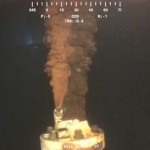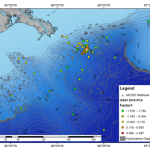The internets are a buzz with a new paper published in Science. You may recall I covered the new paper by Camilli et al. in Science demonstrating that a deep-water oil plume did exist, conclusively, in Gulf of Mexico at the time the researchers sampled, approximately May-June. One of the interesting findings was that at the time of sampling no depreciable reduction in oxygen concentration, an indicator of microbial respiration, was detected. This suggested that microbial degradation of the oil might be low and require months to significantly reduce oxygen in the water column.
In Science published today another team finds significant microbial activity during the same time. The study led by Terry Hazen at Lawrence Berkeley National Laboratory (LBNL) collected 200 samples from 17 sites May 25 and June 2. Using genetics magic, the researchers detected several species of proteobacteria closely related to known petroleum-degraders. In addition, they detected the presence of hydrocarbon-degrading genes in the seawater coinciding with the presence of oil contaminants. Oxygen concentrations dropped within the plume. From incubation experiments and changes in hydrocarbon composition with distance form spill site, the authors suggest that hydrocarbon biodegradation is faster than expected.
With the Deepwater Horizon spill finally choked off, researchers are hoping that marine microbes will help gobble up the millions of barrels of oil still lurking in the gulf. The first peer-reviewed study of the oil—published last week—suggested that the bugs weren’t doing much, however, at least in the plume that was analyzed. But a study published today, which takes a look at the microbes themselves, finds that oil-eating bacteria are flocking to the spill in droves, though it’s not clear how quickly they’re digesting it….”With all of the seepage, including the 40 to 50 million gallons a year that seep naturally into the gulf, we’d have oceans covered with oil slicks if [microbes] weren’t degrading,” says Alan Mearns, a Seattle, Washington–based National Oceanic and Atmospheric Administration marine ecologist, who was not affiliated with either study.
To see if that is actually happening, a group of microbiologists from the University of California, Berkeley, pulled samples of seawater from a plume 1100 meters beneath the surface of the ocean—in the same location as one of the plumes detected by Camilli’s team—and the uncontaminated area surrounding it. Led by microbiologist Terry Hazen of UC Berkeley, the team looked at water both inside and outside the plume, analyzing its chemistry, physics, and even the DNA of its inhabitants. The results, published online today in Science, offer some reassurance: Ocean bacteria are aware of the oily invasion of their territory, and they’re responding accordingly.
…The good news, according to Ronald Atlas, an oil microbiologist at the University of Louisville, Kentucky, is that the oil is definitely breaking up. “Microbes are clearly degrading the oil. The Hazen paper establishes that,” says Atlas, who was not involved in the study. “The question to resolve between the two studies is, what are the real rates of degradation?
You can also find coverage at Wall Street Journal, Science News, and Scientific American. Of course I find HuffPo’s piece the most interesting
The research was supported by an existing grant with the Energy Biosciences Institute, a partnership led by the University of California, Berkeley and the University of Illinois that is funded by a $500 million, 10-year grant from BP.
Is this a conflict of interest? You can decide. Death and Taxes provides some commentary.
Another paper to take note of regarding the oil spill, now only available prepublication to special people, published at Geophysical Research Letters concerns whether deep plumes of oil could cause dead zones in the Gulf. This paper is computer simulation under five different scenarios. The researchers conclude that the ocean hypoxia or toxic concentrations of dissolved oil arising from the Deepwater Horizon blowout are likely to be “locally significant but regionally confined to the northern Gulf of Mexico.” “According to our simulations, these hypoxic areas will be peaking in October,” says study coauthor Robert Hallberg.
The nice thing about this paper, which you can’t get yet, is the summary of the findings given by the authors themselves at the Geophysical Fluid Dynamics Laboratory. At this site you can see some nice animations of modeled Gulf plume under the two scenarios debated above in the papers, microbial and no microbial degradation. You can also see what model simulations of hypoxia forming.
All three of these papers give such a warm and fuzzy feeling about the Gulf but the take home is this. A deep-water plume did exist in the Gulf of Mexico. Some degradation of the oil plume has occurred and hypoxia will occur…of course the extent of both of these is unknown.
PS None of these papers are either open access themselves or in open access journals. Boo to the authors and journals for not making these timely, relevant, and important papers more accessible when information is lacking on this environmental disaster.
Hazen, T., Dubinsky, E., DeSantis, T., Andersen, G., Piceno, Y., Singh, N., Jansson, J., Probst, A., Borglin, S., Fortney, J., Stringfellow, W., Bill, M., Conrad, M., Tom, L., Chavarria, K., Alusi, T., Lamendella, R., Joyner, D., Spier, C., Baelum, J., Auer, M., Zemla, M., Chakraborty, R., Sonnenthal, E., D’haeseleer, P., Holman, H., Osman, S., Lu, Z., Van Nostrand, J., Deng, Y., Zhou, J., & Mason, O. (2010). Deep-Sea Oil Plume Enriches Indigenous Oil-Degrading Bacteria Science DOI: 10.1126/science.1195979
Alistair Adcroft, Robert Hallberg, John P. Dunne, Bonita L. Samuels, J.A. Galt, Christopher H. Barker and Debra Payton (2010), Simulations of underwater plumes of dissolved oil in the Gulf of Mexico, Geophys. Res. Lett., doi:10.1029/2010GL044689, in press.
Share the post "Plumes, Microbes, and Hypoxia…Did, Do, or Will They Exist in the Gulf"






Of course, even IF the oil is getting degraded more quickly than expected, I have no such “warm fuzzies” about the dispersant chemicals.
And yes, boo-hiss on those journals for not making an exception from the publication firewalls for those specific papers!
FYI, the pdf of the second article is available via the authors website. It isn’t published yet so they can do this. Click on the link given above “is the summary of the findings” and click on “[pdf]”.